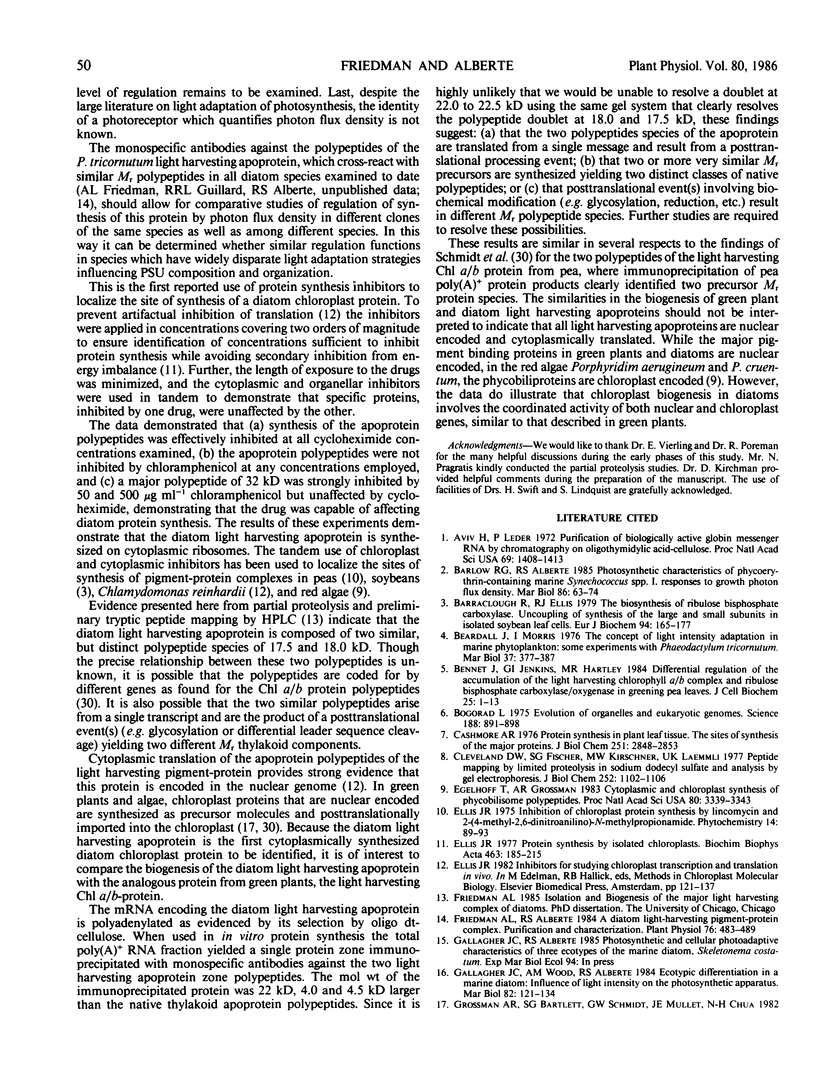Abstract
The apoprotein of the major light harvesting pigment-protein complex from the diatom Phaeodactylum tricornutum (UTEX 646) is composed of two similar polypeptides of 17.5 and 18.0 kilodaltons (kD). The in vivo synthesis of these polypeptides is inhibited by the 80s protein synthesis inhibitor cycloheximide, but not by the 70s ribosome inhibitor chloramphenicol. When total poly(A)+ RNA was used in in vitro protein synthesis, a number of polypeptides were synthesized with a dominant product at 22 kD. When the polypeptides were immunoprecipitated with monospecific antibodies to the 17.5 and 18.0 polypeptides, a single protein zone of 22 kD was detected. Immunoprecipitation with preimmune serum failed to precipitate detectable levels of protein at any relative molecular weight (Mr). These findings indicate that the two apoprotein polypeptides of the diatom light harvesting pigment-protein are translated from polyadenylated message on cytoplasmic ribosomes as either a single or two (or more) similar Mr precursor proteins. These findings also suggest that this protein is encoded in the nucleus.
Photosynthetic light adaptation features of P. tricornutum UTEX 646 indicate that it responds to low light by increasing cell size and numbers of photosystem I and II reaction centers per cell, but does not change photosynthetic rate per cell or photosynthetic unit sizes significantly. When low light cells are exposed to higher photon flux densities, the in vivo incorporation of label into the apoprotein of the light harvesting complex decreases. In contrast, high light grown cells show rapid (<3 hour) increases in apoprotein synthesis when exposed to low light levels. This is the first demonstration of a specific role of photon flux density in regulating the synthesis of a major light harvesting pigment-protein during photosynthetic light adaptation.
Full text
PDF








Images in this article
Selected References
These references are in PubMed. This may not be the complete list of references from this article.
- Aviv H., Leder P. Purification of biologically active globin messenger RNA by chromatography on oligothymidylic acid-cellulose. Proc Natl Acad Sci U S A. 1972 Jun;69(6):1408–1412. doi: 10.1073/pnas.69.6.1408. [DOI] [PMC free article] [PubMed] [Google Scholar]
- Barraclough R., Ellis R. J. The biosynthesis of ribulose bisphosphate carboxylase. Uncoupling of the synthesis of the large and small subunits in isolated soybean leaf cells. Eur J Biochem. 1979 Feb 15;94(1):165–177. doi: 10.1111/j.1432-1033.1979.tb12883.x. [DOI] [PubMed] [Google Scholar]
- Bennett J., Jenkins G. I., Hartley M. R. Differential regulation of the accumulation of the light-harvesting chlorophyll a/b complex and ribulose bisphosphate carboxylase/oxygenase in greening pea leaves. J Cell Biochem. 1984;25(1):1–13. doi: 10.1002/jcb.240250102. [DOI] [PubMed] [Google Scholar]
- Bogorad L. Evolution of organelles and eukaryotic genomes. Science. 1975 May 30;188(4191):891–898. doi: 10.1126/science.1138359. [DOI] [PubMed] [Google Scholar]
- Cashmore A. R. Protein synthesis in plant leaf tissue. The sites of synthesis of the major proteins. J Biol Chem. 1976 May 10;251(9):2848–2853. [PubMed] [Google Scholar]
- Cleveland D. W., Fischer S. G., Kirschner M. W., Laemmli U. K. Peptide mapping by limited proteolysis in sodium dodecyl sulfate and analysis by gel electrophoresis. J Biol Chem. 1977 Feb 10;252(3):1102–1106. [PubMed] [Google Scholar]
- Egelhoff T., Grossman A. Cytoplasmic and chloroplast synthesis of phycobilisome polypeptides. Proc Natl Acad Sci U S A. 1983 Jun;80(11):3339–3343. doi: 10.1073/pnas.80.11.3339. [DOI] [PMC free article] [PubMed] [Google Scholar]
- Friedman A. L., Alberte R. S. A diatom light-harvesting pigment-protein complex : purification and characterization. Plant Physiol. 1984 Oct;76(2):483–489. doi: 10.1104/pp.76.2.483. [DOI] [PMC free article] [PubMed] [Google Scholar]
- Grossman A. R., Bartlett S. G., Schmidt G. W., Mullet J. E., Chua N. H. Optimal conditions for post-translational uptake of proteins by isolated chloroplasts. In vitro synthesis and transport of plastocyanin, ferredoxin-NADP+ oxidoreductase, and fructose-1,6-bisphosphatase. J Biol Chem. 1982 Feb 10;257(3):1558–1563. [PubMed] [Google Scholar]
- Ivarie R. D., Jones P. P. A rapid sensitive assay for specific protein synthesis in cells and in cell-free translations: use of Staphylococcus aureus as an adsorbent for immune complexes. Anal Biochem. 1979 Aug;97(1):24–35. doi: 10.1016/0003-2697(79)90322-1. [DOI] [PubMed] [Google Scholar]
- Kessler S. W. Rapid isolation of antigens from cells with a staphylococcal protein A-antibody adsorbent: parameters of the interaction of antibody-antigen complexes with protein A. J Immunol. 1975 Dec;115(6):1617–1624. [PubMed] [Google Scholar]
- Kursar T. A., Alberte R. S. Photosynthetic Unit Organization in a Red Alga : Relationships between Light-Harvesting Pigments and Reaction Centers. Plant Physiol. 1983 Jun;72(2):409–414. doi: 10.1104/pp.72.2.409. [DOI] [PMC free article] [PubMed] [Google Scholar]
- Laemmli U. K. Cleavage of structural proteins during the assembly of the head of bacteriophage T4. Nature. 1970 Aug 15;227(5259):680–685. doi: 10.1038/227680a0. [DOI] [PubMed] [Google Scholar]
- Laskey R. A., Mills A. D. Quantitative film detection of 3H and 14C in polyacrylamide gels by fluorography. Eur J Biochem. 1975 Aug 15;56(2):335–341. doi: 10.1111/j.1432-1033.1975.tb02238.x. [DOI] [PubMed] [Google Scholar]
- Pelham H. R., Jackson R. J. An efficient mRNA-dependent translation system from reticulocyte lysates. Eur J Biochem. 1976 Aug 1;67(1):247–256. doi: 10.1111/j.1432-1033.1976.tb10656.x. [DOI] [PubMed] [Google Scholar]
- Schmidt G. W., Bartlett S. G., Grossman A. R., Cashmore A. R., Chua N. H. Biosynthetic pathways of two polypeptide subunits of the light-harvesting chlorophyll a/b protein complex. J Cell Biol. 1981 Nov;91(2 Pt 1):468–478. doi: 10.1083/jcb.91.2.468. [DOI] [PMC free article] [PubMed] [Google Scholar]






